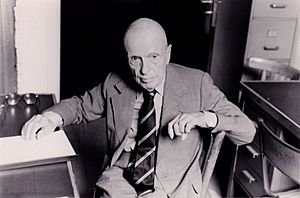Michel Leiris facts for kids
Quick facts for kids
Michel Leiris
|
|
|---|---|

1984 portrait
|
|
| Born | 20 April 1901 |
| Died | 30 September 1990 |
| Occupation | Writer, poet, collector |
| Family | Pierre Leiris |
Michel Leiris was a French writer and a scientist who studied different cultures. He was born in Paris in 1901 and passed away in 1990. He was part of a special art group called the Surrealists. He also became an important researcher in ethnography, which is the study of human cultures.
Contents
Life and Work
Michel Leiris finished high school in 1918. He first tried studying chemistry, but soon became very interested in jazz music and writing poetry.
Joining the Surrealists
Between 1921 and 1924, Leiris met many important people. These included famous artists and writers like Max Jacob and Jean Dubuffet. He also met the artist André Masson, who became his teacher and friend. Through Masson, Leiris joined the Surrealist movement. Surrealism was an art and writing style that explored dreams and the imagination. Leiris wrote for their magazine, La Révolution surréaliste. He also published his own surrealist works, like Simulacre (1925) and Le Point Cardinal (1927). His surrealist novel, Aurora, was written between 1927 and 1928. In 1926, he married Louise Godon. She was the stepdaughter of Picasso's art dealer, Daniel-Henry Kahnweiler.
Exploring Cultures
In 1929, Leiris decided to leave the Surrealist group. He then joined a team led by Georges Bataille for a magazine called Documents. He wrote many articles for this magazine. These articles covered topics from old figures to modern artists like Giacometti and Picasso.
In 1930, Leiris went on a big trip to Africa. He joined Marcel Griaule's important study trip, called the Dakar-Djibouti mission. This trip was about studying different cultures. After this experience, Leiris wrote his first major book in 1934, called L’Afrique fantôme (Phantom Africa). This book was special because it mixed his studies of cultures with his own personal story. It was a new way to write about ethnography. When he came back, he started working as an ethnographer at the Musée de l'Homme (Museum of Man). He worked there until 1971.
Social and Political Involvement
In 1937, Leiris, Bataille, and Roger Caillois started the Collège de sociologie. This group discussed how society works, especially during a time of global change. Leiris became more and more interested in politics. In 1945, he went on a trip to Côte d'Ivoire to study the French colonies.
Leiris was also part of the team for a magazine called Les Temps modernes, led by Jean-Paul Sartre. He was involved in important political discussions. For example, he supported people fighting for fairness during the Algerian War. He was one of the first to sign a statement in 1960 that supported the fight against colonial forces in Algeria.
Later Years and Legacy
In 1961, Leiris became a lead researcher in ethnography at the C.N.R.S. (Centre national de la recherche scientifique). He wrote many important articles about artists he admired, like Francis Bacon, who was a close friend. That same year, he published Nights as Day, Days as Night.
Michel Leiris is seen as a very important person in French literature and cultural studies of the 20th century. He wrote many books and articles. These include:
- Autobiographies, where he wrote about his own life, like L'Age d'homme (1939) and La Règle du jeu (1948–1976).
- Art criticism, where he wrote about art, such as Francis Bacon face et profil (1983).
- Music criticism, like Operratiques (1992).
- Scientific studies, such as La Langue secrète des Dogons de Saga (1948).
His studies in anthropology covered many topics, from bullfighting to special ceremonies in Gondar, Ethiopia.
In 1986, Leiris started an anthropology journal called Gradhiva with Jean Jamin. This journal is now an important publication for the Musée du quai Branly in Paris.
Leiris was also a very talented poet. Poetry was important to how he understood the world. He once said that poetry helps us see others as equals. He believed that poetic inspiration was a rare and special gift.
Works (selection)
- Simulacre (1925)
- Le Point Cardinal (1927)
- Aurora (1927–28)
- L’Afrique fantôme (1934); Phantom Africa (Eng. translation, Brent Hayes Edwards, Seagull Books, 2018)
- L’Âge d’homme (1939); Manhood (Eng. translation, Richard Howard, University of Chicago Press, 1992)
- Haut Mal (poems) (1943) / reprinted as Haut Mal, suivi de Autres lancers (1969)
- La Langue secrète des Dogons de Saga (1948)
- La règle du jeu (1948–1976); The Rules of the Game
- Vol. 1: Biffures (1948) (Eng. translation: Scratches, Lydia Davis, 1997)
- Vol. 2: Fourbis (1955) (Eng. tr. Scraps, Lydia Davis, 1997)
- Vol. 3: Fibrilles (1966) (Eng. tr. Fibrils, Lydia Davis, 2017)
- Vol. 4: Frêle Bruit (1976)
- Race et civilisation (1951)
- La Possession et ses aspects théatraux chez les Éthiopiens du Gondar (1958)
- Nuits sans nuit et quelques jours sans jour (1961); Nights as Day, Days as Night (Eng. translation, Richard Sieburth, Spurl Editions, 2017)
- Brisées (1966) (Eng. translation, Lydia Davis, North Point Press, 1990)
- Au verso des images (1980)
- Le Ruban au cou d'Olympia (1981) (Eng. translation: The Ribbon at Olympia's Throat, Christine Pichini, 2019)
- Francis Bacon face et profil (1983)
- Operratiques (1992)
- Journal 1922-1989 (1992)
See also
 In Spanish: Michel Leiris para niños
In Spanish: Michel Leiris para niños
- Limit-experience

